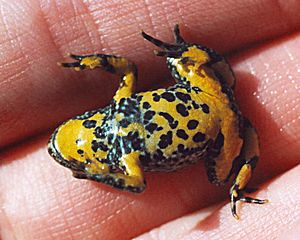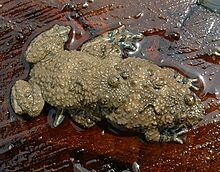Yellow-bellied toad facts for kids
Quick facts for kids Yellow-bellied toad |
|
|---|---|
 |
|
 |
|
| Conservation status | |
| Scientific classification | |
 |
|
| Distribution of the yellow-bellied toad (in green) |
The yellow-bellied toad (Bombina variegata) is a type of frog that belongs to the group called fire-bellied toads. You can find this toad mostly in western Europe, with a few groups in eastern Europe too. Even though the number of these toads is slowly going down, they are not yet considered in danger of disappearing. Efforts are being made, especially in Germany, to help their population grow before it's too late.
This toad is easy to spot because of its bright yellow belly. Its back is usually dark brown and green. The toad uses its colors to camouflage itself from animals that might want to eat it. If it feels threatened, it will show off its bright yellow belly as a warning. The bumps, or warts, on its back can also release toxins (poisons) when needed to protect itself.
Scientists find the yellow-bellied toad interesting because of how it chooses to breed. It often picks shallow, risky places to lay its eggs, which might dry up quickly. Because of this special breeding habit, things like climate change and habitat fragmentation (when their living areas get broken up) can really affect these toads.
Contents
What Does the Yellow-Bellied Toad Look Like?
Yellow-bellied toads are small, usually 28 to 56 millimeters long (about 1 to 2 inches). They typically weigh between 2.3 and 12 grams. This makes them among the smaller members of their toad family, where some can grow up to 7 centimeters (almost 3 inches).
Their top side is grey-brown, sometimes with faded, lighter spots. But their underside, including their legs, fingers, and toes, is grey-blue to black-blue with bright yellow or orange spots. These colorful spots usually cover more than half of their belly.
Yellow-bellied toads have round bodies and a rounded snout. Their eyes have heart-shaped pupils, and you can't see their eardrums. Their back has many warts with swirly patterns. Studies have shown that male toads have longer front limbs than females. This is thought to help them when they are mating or fighting other males.
How Yellow-Bellied Toad Colors Vary
In 1968, scientists studied yellow-bellied toads in Romania and the USSR. They found eight different patterns of yellow and black on the toads' undersides. These patterns ranged from almost completely yellow to almost completely black. They also noticed that toads from northern areas usually had more black markings on their bellies than those from southern areas.
Where Do Yellow-Bellied Toads Live?
The yellow-bellied toad mostly lives in mountainous areas, especially in Western Europe. There are two main types of Bombina toads in Europe: Bombina variegata (the yellow-bellied toad) and Bombina bombina. The Bombina bombina has spread more widely after the last ice age, so you might find fewer yellow-bellied toads in some places.
The yellow-bellied toad is found in smaller, more separate areas. Countries like France, Germany, Belgium, and the Netherlands are common places to find them. However, because their homes are being disturbed, the areas where yellow-bellied toads live have become much smaller.
Protecting Yellow-Bellied Toads
Many things linked to climate change are causing the yellow-bellied toad population to shrink. These include losing their homes, losing genetic variety (which makes them less able to adapt), and diseases spreading more easily. To help them, we need to understand the exact problems at local, regional, and even continent-wide levels. Each level needs different solutions, and many efforts are needed to make sure the species is no longer in danger.
In recent years, these toads have become very isolated because their living areas have been broken up (habitat fragmentation). This can lead to less genetic diversity and more inbreeding (when closely related animals breed). When both problems happen, the lack of genetic diversity is very clear. So, current efforts to protect them must focus on improving their habitats to increase genetic diversity.
The yellow-bellied toad is considered endangered in Germany. Scientists have tried to increase their numbers by moving toads from crowded areas to places where there are fewer toads. For this to work, it's very important that the toads can change their skin color to match their new environment. Because some toads are better at changing their color than others, researchers need to check this ability before moving them.
Another issue with moving toads is the risk of spreading diseases. To help the toads interact more and increase genetic variety through breeding, conservation efforts across Europe should focus on creating metapopulations. This means connecting different groups of toads so they can breed with each other.
Reproduction and Life Cycle
Female yellow-bellied toads can lay eggs multiple times during one mating season, and some can live for many years. However, it's rare for a female to actually lay eggs more than once a year. They also don't lay many eggs at a time, usually around 40, even though they could lay over 200. This is because if adult toads are likely to survive for a long time, there's less need to produce many offspring, especially if the young might not survive well.
How Long Do Yellow-Bellied Toads Live?
Yellow-bellied toads can live anywhere from 5 to 23 years. How long they live depends on things like the climate, their habitat, and how much food is available. Climate is especially important because it affects how predictable their home is and if there are good places to breed.
Being eaten by predators also affects their lifespan. Yellow-bellied toads have ways to protect themselves, like secreting toxins from their skin, which makes them less appealing to predators. This helps them live longer. Interestingly, different groups of yellow-bellied toads can have very different lifespans, and climate conditions play a big role in these differences.
Yellow-Bellied Toad Life Cycle
Tadpoles grow quickly and can reach 55 millimeters in length. They have a blunt tail and are usually grayish-brown, though sometimes they can be transparent. Both tadpoles and eggs can be eaten by small creatures that live in ponds, such as leeches, fish, and some water beetles. A study in 2016 found that tadpoles in warmer water grow faster than those in cooler water. This helps them develop quickly in different environments, like sunny quarries versus shaded forest areas.
Mating Behavior
Male Toad Interactions
When a male toad that owns a territory meets another male toad that enters its area, the owner will move towards the intruder and start a fight. During the fight, each male tries to climb onto the other's back. The winner will eventually hold the other toad down with its legs while climbing on top. The losing toad then swims away, and the winner starts making high-frequency waves in the water, showing that it has claimed its territory.
Parental Care
Choosing Where to Lay Eggs
The yellow-bellied toad can breed in unpredictable places, even in shallow pools that might dry up overnight. Among its family, the yellow-bellied toad is the only species that chooses such risky spots to lay its eggs.
The yellow-bellied toad prefers to lay eggs in ponds that are a certain temperature and last for a specific amount of time. If given a choice between a warm pond and a cooler one, the frog will choose the warmer pond. This is because heat helps the eggs grow and develop well, which increases the frog's chances of having healthy offspring.
The toad also prefers ponds that last for a medium amount of time. If a pond lasts too long, there's a risk of many predators appearing that could eat the eggs. If a pond is too short-lived, there might be too few predators, but there's a high risk of the pond drying up and killing all the eggs. A key part of choosing a site is that the eggs can develop quickly. Site selection and fast development are very important for survival, as most deaths happen at this stage. It was found that how long a pond lasts is more critical for site selection than the risk of being eaten by predators. Unlike predation, a pond drying up can kill an entire group of tadpoles or eggs.
How Yellow-Bellied Toads Protect Themselves
The yellow-bellied toad's dark brown or green back helps it camouflage itself against predators. This allows the frog to blend in with its surroundings. However, its belly is bright yellow, and this is a warning signal called aposematism. It tells predators that the toad's skin is poisonous.
Different yellow-bellied toads have slightly different shades of dark on their backs and yellow on their bellies, depending on where they live. They can also change the shade of their color to better hide when they move to lighter or darker places. Some toads naturally have brighter colors. These toads have been seen covering themselves with pond soil, suggesting they know their bright back doesn't hide them perfectly. This ability to quickly change color is done by moving tiny pigment-filled sacs called melanosomes within their cells. Being able to change color quickly is very important for reducing the time the frog is easily seen by predators. The longer they stand out, the higher the risk of being eaten.
The warts on the yellow-bellied toad's back have venom glands that can open when the toad feels threatened. The difference between its camouflaged back and its bright yellow belly allows the toad to stay hidden most of the time, only flashing its colors when it's in danger.
Common defense actions include trying to escape, showing a full threat display, or a partial threat display. The toad might also puff up its chest, which can discourage predators who prefer to swallow their prey whole. The most passive defense is staying still, trying to hide as much as possible and avoid a fight. While the yellow-bellied toad's toxin is not deadly to humans, it can cause discomfort to most animals and is fatal to smaller ones.
The type of defense mechanism used by yellow-bellied toads can vary a lot between different groups of toads, even more than between different species. This is because of the different types of predators they face. For example, if a toad often encounters snakes, it will use the "puffing up" defense more often than toads that have never seen a snake.
Other Names for the Yellow-Bellied Toad
- Rana variegata, Linnaeus, 1758
- Bombynator pachypus, Bonaparte 1838




